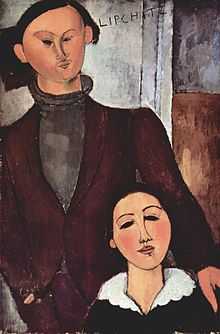School of Paris

School of Paris (French: École de Paris) refers to three distinct groups of artists: a group of medieval manuscript illuminators, and a group of non-French artists working in Paris before World War I, and a similar group of artists living in Paris between the two world wars and beyond.
Medieval illuminators
The School of Paris also refers to the many manuscript illuminators, whose identities are mostly unknown, who made Paris an internationally important centre of illumination throughout the Romanesque and Gothic periods of the Middle Ages, and for some time into the Renaissance. The most famous of these artists were Jean Pucelle and Jean Fouquet. The Limbourg brothers, originally from the Netherlands, also spent time in Paris, as well as Burgundy and Bourges, but their style is not typical of the Paris of the day. Many of the painters in Parisian workshops were women.
Modern School of Paris

The School of Paris describes, not an art movement or a learning institution, but instead is more indicative of the importance of Paris as a center of Western art in the early decades of the 20th century.
The group of non-French artists in Paris before World War I created in the styles of Post-Impressionism, Cubism, Fauvism, and includes artists like Pablo Picasso, Marc Chagall, Amedeo Modigliani and Piet Mondrian. French artists included Pierre Bonnard, Henri Matisse, Jean Metzinger and Albert Gleizes.
Many of these same artists, plus Jean Arp, Robert Delaunay, Sonia Delaunay, Joan Miró, Constantin Brâncuși, Raoul Dufy, Tsuguharu Foujita, Emmanuel Mané-Katz; the Artists from Belarus, including Chaim Soutine, Michel Kikoine, Pinchus Kremegne, Ossip Zadkine, Jacques Lipchitz; the Russian prince born in Saint Petersburg Alexis Arapoff, and others worked in Paris between World War I and World War II, in various styles including Surrealism and Dada. A significant group of Jewish artists working together came to be known as the Jewish School of Paris. This group included Mané-Katz, Soutine, Marc Chagall, Moise Kisling, and Jules Pascin.[1]
After the Second World War the term School of Paris often referred to Tachisme, Lyrical Abstraction, the European parallel to American abstract expressionism and those artists are also related to Cobra. Important proponents were Jean Dubuffet, Zoran Music Pierre Soulages, Nicolas de Staël, Hans Hartung, Serge Poliakoff, Bram van Velde, Georges Mathieu and Jean Messagier, among others. Many of their exhibitions took place at the Galerie de France.
Gallery
-

Robert Delaunay, Simultaneous Contrasts: Sun and Moon, 1912-13, oil on canvas, The Museum of Modern Art, New York City
-
%2C_oil_on_canvas%2C_51.4_x_68.6_cm%2C_Fogg_Art_Museum%2C_Harvard_University.jpg)
Jean Metzinger, Landscape (Marine, Composition Cubiste), 1912, oil on canvas, Fogg Art Museum, Harvard University
-

Amedeo Modigliani, Portrait of Chaïm Soutine, (1916)
See also
References
- ↑ Ehrlich, M. Avrum, ed. (2008). Encyclopedia of the Jewish Diaspora: Origins, Experiences, and Culture 1. Santa Barbara, CA: ABC-CLIO. p. 829.
Further reading
- West, Shearer (1996). The Bullfinch Guide to Art. UK: Bloomsbury Publishing Plc. ISBN 978-0-8212-2137-2.
- Nieszawer, Nadine (2000). Peintres Juifs à Paris 1905-1939. france: Denoel. ISBN 978-2-207-25142-3.
External links
| Wikimedia Commons has media related to École de Paris. |
- (French) (English) Nadine Nieszawer's website, dedicated to the School of Paris 1905-1939 (includes many biographies)
- French illuminated manuscripts: late fourteenth to early sixteenth century - British Library
- The Second Spanish School of Paris
- Website for Jewish art of the School of Paris circle
- school-of-paris.org : community website open to any fan to Ecole de Paris in the world
